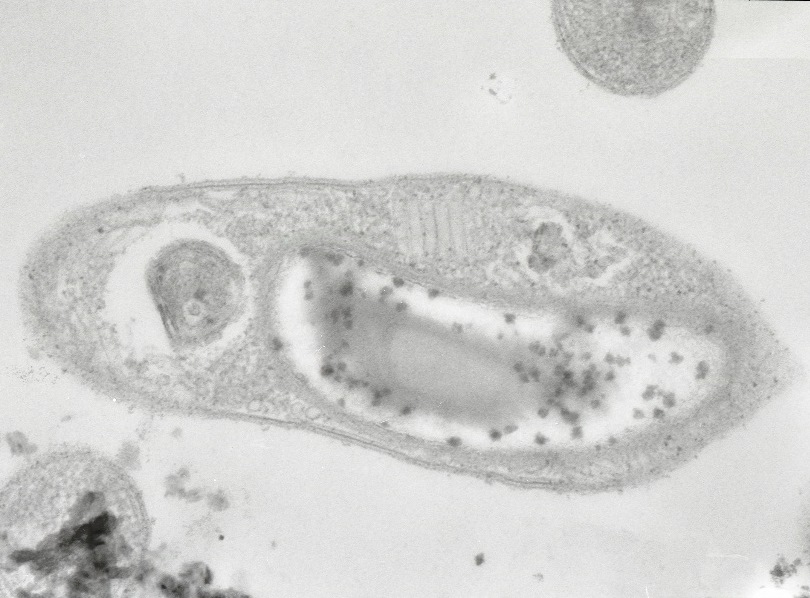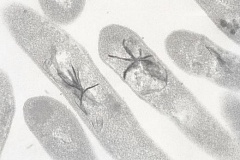TSU microbiologists were the first in the world to isolate Desulforudis audaxviator from deep underground waters. Translated from Latin, its name means “a brave traveler”. Scientists from different countries have hunted for this bacterium for over 10 years. The increased interest by researchers is because the microorganism receives energy in the absence of light and oxygen. Theoretically, this method makes life possible in space, for example, on Mars. The results of their studies are published in the highly ranked journal ISME of the publishing group Nature.
- The existence of Desulforudis audaxviator, living deep underground, became known more than 10 years ago,- says Olga Karnachuk, head of the TSU Department of Plant Physiology and Biotechnology and lead author - Its genetic trail was found by American scientists, in the DNA of a microorganism in the mine waters of a gold mine located in South Africa. Sampling was carried out at a depth of 1.5 to 3 kilometers, where there is neither light nor oxygen. Not so long ago, it was believed that life in these conditions is impossible because without light there is no photosynthesis underlying all food chains. But it turned out that this assumption is wrong.
One of the clearest evidences of this is the “black smokers” found on the ocean floor. But, in contrast to them, the Desulforudis audaxviator lives underground in complete solitude - except for its DNA, no trace of others was found in the samples. After the publication of an article by American researchers in the journal Science, scientists from different countries began a search for the bacteria.
Its DNA was found in water samples in Finland and in the US, but no one could catch the bacterium itself. One of the assumptions explaining this was that the bacterium divides every thousand years. However, Russian scientists who are TSU microbiologists were able to isolate the Desulforudis audaxviator. It was found in the underground waters of a thermal spring located in the Verkhneketsky District of the Tomsk Region. The scientists were aided in their search by the extensive practical experience accumulated earlier on the isolation of complex sulfate-reducing bacteria.
Sulfate-reducing bacteria are among the most ancient microorganisms on the planet. This diverse group of prokaryotes is distinguished by the ability to receive energy in the absence of oxygen due to the consumption of sulfates and the oxidation of hydrogen or simple organic compounds. Among sulfate-reducing bacteria, there are thermophilic microorganisms that can live and multiply at temperatures from + 50°C to + 93°C.
- The studies were conducted jointly with our longtime partners, specialists at the Federal Testing Center Biotechnology of the Russian Academy of Sciences that have extensive experience in DNA sequencing,- says Olga Karnachuk. - A group of Moscow experts under the guidance of Professor Nikolai Ravin looked at the samples that we selected from the searches of oil wells in the north of the region. The DNA of the bacteria was found in the samples taken in White Yar. .
Some time after that, TSU scientists managed to isolate the bacterium and obtain new data about it. First, it became known that the bacterium divides more than once every thousand years, actually once every 28 hours, that is, almost daily.

Second, it turned out that Desulforudis audaxviator is almost omnivorous: in the laboratory, it “ate” sugar, alcohol, and much more. However, best of all, according to the researchers, the bacterium feels itself on the “diet”, that is, habitually eating hydrogen, from which it receives the most energy. In addition, it turned out that oxygen, which at first was considered destructive for an underground microbe, does not kill it.
Third, scientists have identified the structures of the bacteria, which apparently help them travel throughout the world: the smallest bubbles, gas vacuoles, similar to the swim bladder of fish. However, the pathways of movement of the bacteria are still unknown. Underground reservoirs in which the DNA of the microorganism was found were never geologically in contact. The scientists’ hypothesis is that the bacterium travels through the air, falling to great depths in the surface open water bodies, and is transported with small particles of aerosol.
And finally, another surprising fact is that the genome of the bacterium found in Siberia is almost identical to the DNA of the bacteria from South Africa.
- It shouldn't be like that, a mystery that we don’t understand, adds Olga Karnachuk. - The fact is that mutations are always present. Even when the same bacterium is cultivated in the laboratory, over time differences in DNA appear. In this case, they do not. And it is not clear why. The answer to this question is connected with some basic fundamentals of living cells that have not yet been studied, therefore the explanation of this genetic similarity is a matter of the future, something that scientists still have to work on.
The Latin name of the bacterium Desulforudis audaxviator comes from a quote from Jules Verne's novel Journey to the Center of the Earth. His hero, Professor Liddenbrock, shows a Latin inscription: “Descende, audax viator, et terrestre centrum attinges” (“Descend, brave traveler, and reach the center of the Earth”).

